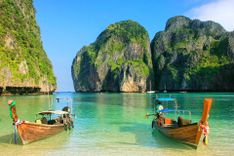Night safaris
A much-touted park attraction is the hour-long night safaris, or “night-lightings”, which take truckloads of tourists round Khao Yai’s main roads in the hope of catching some interesting wildlife in the glare of the specially fitted searchlights.
Night-time sightings often include deer and civets, and if you’re very lucky you might see elephants too. Opinions differ on the quality of the experience: some find it thrilling to be out on the edges of the jungle after dark, others see it as rather a crass method of wildlife observation, especially at weekends, when the park can feel like a town centre, with four or five trucks following each other round and round the main roads.
All night-lightings are run by the park rangers, so tour operators sometimes join forces to hire a truck with ranger and searchlights. If you’re on your own, you’ll probably need to accompany one of these groups.
The safaris depart the park headquarters every night at 7pm and 8pm (they can pick you up from the campsite if requested); trucks cost B500 to rent and can take up to ten people: book your place at the national park accommodation office, next to the visitor centre.
Khao Yai’s wildlife
During the daytime you’re bound to hear some of the local wildlife, even if you don’t catch sight of it. Noisiest of all are the white-handed (lar) gibbons, which hoot and whoop from the tops of the tallest trees, and the bubbling trills of the pileated (capped) gibbons. Gibbons generally avoid contact with the ground, unlike the hard-to-miss pig-tailed macaques, many of which gather at favoured spots on the road through the park. Hornbills also create quite a racket, calling and flapping their enormous wings; Khao Yai harbours large flocks of four different hornbill species, which makes it one of the best observation sites in Southeast Asia. The great hornbill is particularly beautiful, with brilliant yellow and black undersides and a 2m wingspan; the magnificent oriental pied hornbill boasts less striking black and white colouring, but is more commonly seen at close range because it swoops down to catch fish, rats and reptiles. You might also see red-headed trogons, orange-breasted trogons, woodpeckers and Asian fairy-bluebirds, and, if you’re very lucky, silver pheasants or Siamese firebacks, endemic only to Thailand and western Cambodia. From November to March Khao Yai hosts several species of migrant birds, including the dramatically coloured Siberian thrush and the orange-headed thrush.
A herd of between 200 and 250 Asian elephants lives in the park, and its members are often seen at night – it’s the only place in Thailand where you have much chance of spotting wild elephants. Khao Yai is also home to a very small number of tigers, sightings of which are extremely rare. You’re almost certain to spot civets, and you might come across a slow loris, while barking and sambar deer are less nervous after dark. Wrinkle-lipped bats assemble en masse at sunset, especially at the cave entrance next to Wat Tham Silathong, just outside the north (main) gate into the park, which every evening disgorges millions of them on their nightly forage.
Leeches
If hiking during or just after the rainy season you will almost certainly have some unsolicited encounters with leeches; mosquito repellent helps deter them, as do leech socks (canvas gaiters), available from the cafeteria complex opposite the visitor centre, or in the nearby accommodation office (B70/pair, although unless you want to keep them as a souvenir, you should insist on borrowing a pair from your tour guide). To get leeches off your skin, burn them with a cigarette or lighter, or douse them in salt; oily suntan lotion or insect repellent can make them lose their grip and fall off.





